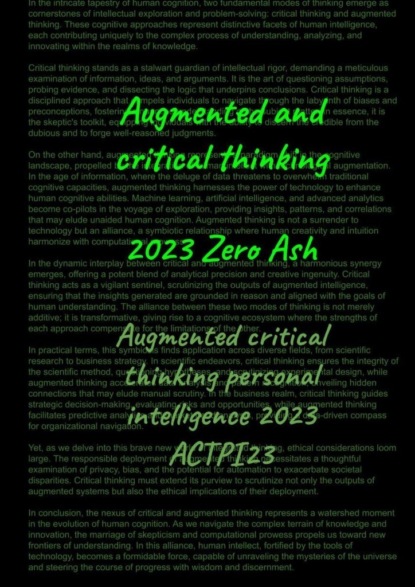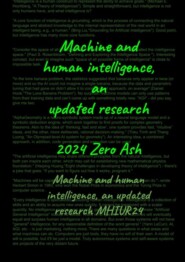По всем вопросам обращайтесь на: info@litportal.ru
(©) 2003-2024.
✖
Настройки чтения
Размер шрифта
Высота строк
Поля
First principles thinking is a problem-solving and decision-making approach that involves breaking down complex problems into their most fundamental elements or components. It seeks to understand a subject or situation from the ground up, starting with basic, self-evident truths or axioms.
This approach is often used in fields like engineering, physics, and entrepreneurship, where it’s essential to innovate and solve problems by reevaluating assumptions. For example, Elon Musk has popularized the use of first principles thinking in his business ventures, such as designing SpaceX rockets and Tesla electric cars.
First principles thinking involves deconstructing problems into their core components, questioning existing assumptions, and building solutions or insights from the ground up. It is particularly effective for creative problem-solving and innovation.
The primary difference between first principles thinking and critical thinking lies in their focus and purpose. First principles thinking is a problem-solving approach that aims to innovate by breaking down complex problems to their fundamental elements, while critical thinking is a more general cognitive skill used to evaluate information, arguments, and reasoning. Critical thinking can be applied in various contexts, including assessing the results and conclusions of first principles thinking, to ensure they are logically sound and valid.
First principles thinking is a powerful framework for innovation that involves breaking down complex problems into their fundamental elements and then reconstructing solutions from scratch, relying on basic principles and fundamental truths rather than existing conventions or assumptions. By questioning traditional approaches and starting from the most basic components of a problem, innovators delve deeper and develop creative, original solutions. This method encourages fresh thinking, enabling people to identify opportunities, solve complex problems, and pioneer new inventions in fields ranging from science and technology to business and design.
Critical commentary. The first principles are spoken about among techno entrepreneurs who are trying to create new solutions. We can say thinking based on first principles is a framework for innovation. The idea is simple, since we know that all knowledge systems are built on basic blocks of axioms and blocks of knowledge derived from logical conclusions. Then, in order to search for innovations, you can discard all existing old logically obtained blocks and try to build new ones. The most audacious can also revise the axioms. Such a revision of the foundations can lead to the so-called «disruption», that is, a fundamental change. But it’s not easy, the task is not just to come up with something new, but also more effective than the old one.
Logical and critical thinking
Logical thinking and critical thinking are related concepts, but they have distinct differences in their focus and application.
Logical thinking involves the use of formal and informal logic to arrive at valid conclusions or make sound judgments. It is primarily concerned with the structure of arguments and the consistency of reasoning.
Logical thinking is more focused on the rules and principles of logic, including deductive reasoning (drawing specific conclusions from general premises) and inductive reasoning (making general conclusions from specific observations).
Logical thinking emphasizes the identification and avoidance of logical fallacies, such as circular reasoning, false dichotomies, and non sequiturs. It aims to ensure that arguments follow a valid and coherent structure.
Logical thinking is a subset of critical thinking, focusing primarily on the structure of arguments and the application of formal and informal logic to ensure valid conclusions. Critical thinking is a more comprehensive cognitive skill that includes logical thinking but also extends to other skills that help individuals assess, analyze, and make reasoned judgments about various aspects of life and information, including ethical and practical considerations.
Critical thinking is a multifaceted cognitive skill that involves several components and is closely related to various aspects. When considering critical thinking, it’s important to take into account the following related concepts and factors: problem solving, decision-making, information literacy, analytical skills, inferential reasoning, deductive and inductive reasoning, skepticism, logic and logical fallacies, cognitive biases, emotional intelligence, ethical considerations, metacognition, open-mindedness, communication skills, problem identification, education and training, cross-disciplinary application (so many things!).
Understanding and developing these related aspects can help individuals become more proficient in critical thinking, which is a valuable skill in a wide range of personal, academic, and professional endeavors.
Critical comment. A joke about logic. Logician’s wife advised him to go to the store to buy a loaf of bread and if they have eggs, he will have to buy a dozen. The logician went to the store and returned home with 12 loaves of bread. His wife asked why he bought so many loaves of bread. The logician replied: «Because they had eggs!». You also need to use logical thinking critically.
Creative and critical thinking
Creative thinking and critical thinking are distinct cognitive processes that serve different purposes and have varying characteristics.
Creative thinking is the ability to generate innovative and novel ideas, solutions, and concepts. It involves thinking «outside the box» and exploring unconventional, imaginative, and original possibilities.
Creative thinking often involves diverging from traditional or established thought patterns to explore a wide range of ideas and perspectives.
Creative thinking requires using one’s imagination to come up with fresh and unique solutions or ideas.
Creativity thrives when individuals are open to new experiences, perspectives, and possibilities.
Creative thinking doesn’t follow a linear or structured process. It encourages exploration, experimentation, and free association of ideas.
Emotions and personal experiences can play a significant role in creative thinking, as they can inspire or inform the generation of new ideas.
Critical thinking is the process of objectively evaluating, analyzing, and assessing information, arguments, or situations to make well-informed decisions or judgments. It is a structured, systematic, and analytical approach to problem-solving and decision-making.
Critical thinking involves the careful examination and assessment of information, arguments, or evidence to determine their validity, relevance, and reliability.
Critical thinking relies on logical reasoning and sound argumentation. It aims to make decisions based on rationality and evidence.
Critical thinking seeks to minimize personal biases and emotions, focusing on objective and verifiable information.
While creative thinking generates ideas, critical thinking helps to choose the best among those ideas and formulate effective solutions.
Critical thinking often follows a structured process that includes identifying issues, gathering relevant data, evaluating options, and making reasoned judgments.
Creative thinking is about generating innovative and imaginative ideas, while critical thinking is about analyzing, evaluating, and making informed decisions based on evidence and logical reasoning. Both types of thinking are valuable and can complement each other in problem-solving and decision-making processes. Creative thinking can help generate a variety of solutions, while critical thinking can help assess those solutions and determine the most appropriate course of action.
Creative thinking is the ability to generate novel and imaginative ideas, solutions, and concepts by breaking away from conventional patterns of thought. It involves exploring new perspectives, making unexpected connections, and embracing a willingness to take risks and challenge established norms. Creative thinking is a valuable skill in problem-solving, innovation, and artistic expression, enabling individuals to tackle complex issues, foster innovation, and manifest their unique visions and ideas in a world that constantly demands fresh and inventive approaches.
Critical comment. Fun thought. Creativity is a lot like a box of chocolates. You never know what you’re going to create, but it’s sure to be sweet!
Critical thinking and troubleshooting
Troubleshooting and critical thinking are related concepts, but they have distinct differences.
Troubleshooting is a systematic approach to problem-solving, often used in technical and practical contexts. It typically involves identifying and resolving specific issues or malfunctions in a system, process, or device. Here are some key characteristics of troubleshooting.
Troubleshooting focuses on finding solutions to well-defined problems or issues. It usually begins with a clear problem statement or symptom.
Troubleshooting often follows a step-by-step procedure or checklist to diagnose and address the problem. It can be highly structured and relies on known techniques or best practices.
Effective troubleshooting often requires specialized knowledge or expertise in a particular domain or field.
The primary goal of troubleshooting is to restore a system to normal functioning by fixing the identified issue.
The key difference between troubleshooting and critical thinking is that troubleshooting is a specific problem-solving approach, often focused on practical issues, while critical thinking is a more general cognitive skill that involves analyzing, evaluating, and synthesizing information and ideas in a wide range of contexts. Critical thinking can be an important component of effective troubleshooting, as it helps individuals make informed decisions and consider various solutions during the troubleshooting process.
Troubleshooting is a systematic problem-solving process aimed at identifying and resolving issues or malfunctions in various contexts, such as technology, machinery, systems, and everyday situations. It involves a methodical approach of diagnosing the root causes of problems, often through a series of logical steps and tests, in order to find effective solutions. Troubleshooting requires critical thinking, deductive reasoning, and the ability to isolate issues by breaking them down into manageable components. It is a vital skill in resolving technical problems, maintaining efficiency in processes, and ensuring the smooth operation of complex systems, ultimately contributing to the functionality and reliability of various systems and environments.
Critical comment. So much for troubleshooting, there is no need for critical thinking, go through the list and fix problems – a joke. Just as troubleshooting skills are useful in critical thinking, so critical thinking is necessary for troubleshooting.
Critical thinking in consulting
Consulting is a multifaceted field that requires professionals to navigate complex challenges and provide valuable solutions to a diverse range of clients. At the heart of effective consulting lies critical thinking – the ability to analyze, evaluate, and synthesize information to make informed decisions and recommendations. In this research, we will explore the significance of critical thinking in consulting, the key components of critical thinking in this context, and its impact on the success of consulting projects.
Critical thinking is the cornerstone of consulting success. It involves the systematic evaluation of information, ideas, and assumptions to reach well-founded conclusions. In consulting, this skill is indispensable because consultants are often brought in to solve problems, make decisions, and provide expert advice. Effective consultants must think critically to add value to their clients’ organizations.
Consultants are frequently hired to address complex problems. Critical thinking allows them to dissect these issues, identify their root causes, and propose viable solutions. Without this skill, consultants risk offering superficial or ineffective remedies.
Consultants often assist clients in making pivotal decisions that can significantly impact their organizations. Critical thinking enables them to analyze alternatives, evaluate potential risks, and make informed recommendations.
Critical thinking encourages consultants to think outside the box and generate innovative ideas. This creativity can be invaluable in finding unique solutions to longstanding problems.
Consultants must gather and analyze a wealth of data, from financial reports to market trends. Critical thinking helps them discern relevant from irrelevant information, identify patterns, and draw meaningful conclusions.
Critical thinkers can identify the underlying issues that contribute to a problem. They don’t merely address symptoms but delve into the root causes, which is essential for long-term solutions.






